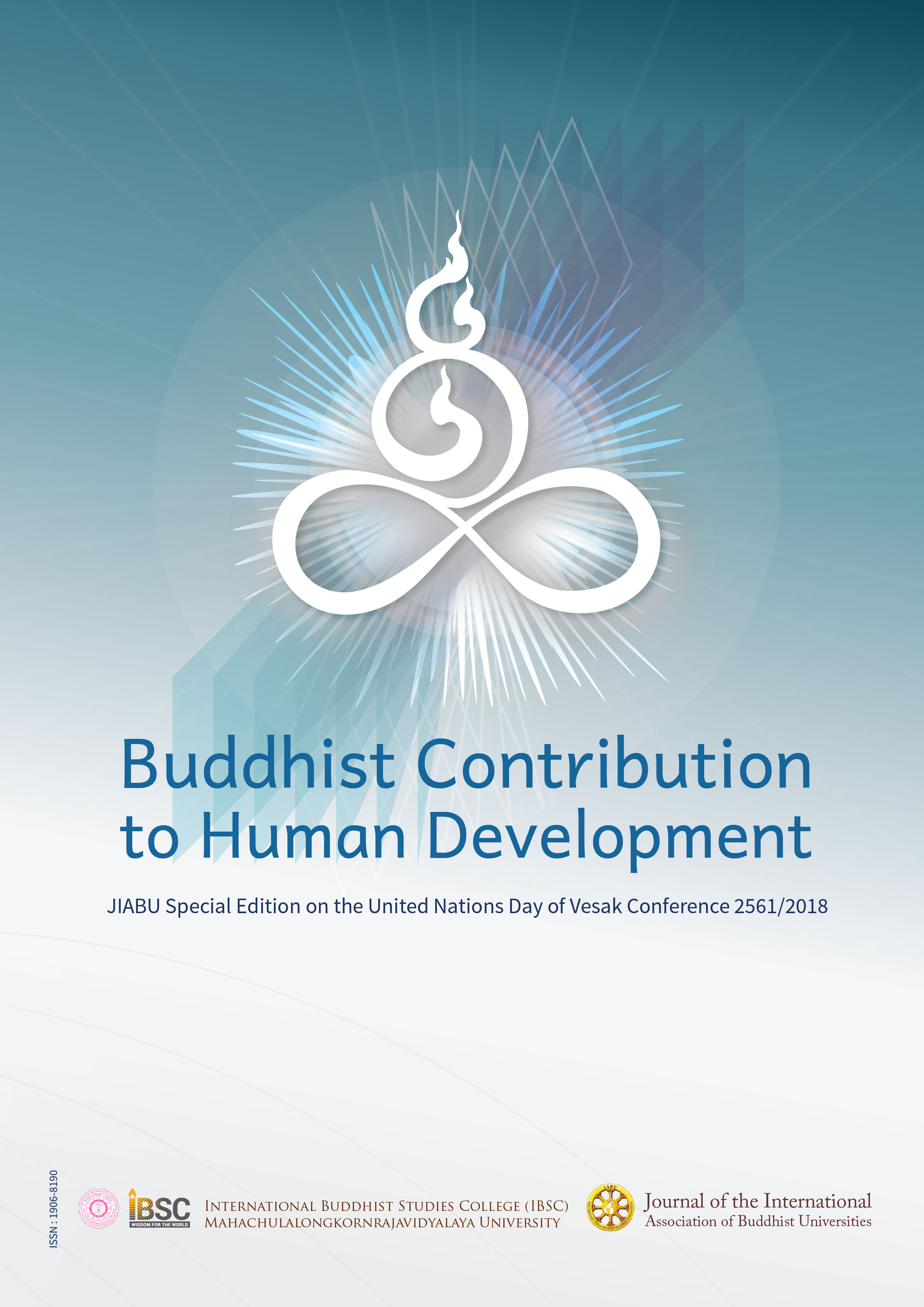Nonviolent Buddhist Peace Work: Textual Support for Nonviolent Peace Work in Early Buddhism
Main Article Content
Abstract
In this paper, I will explore if there is evidence for the support of nonviolent peace
work in the early Buddhist tradition. First, I will describe the social science’s definitions
for the three modalities of peace work, then I will highlight current peace organizations and
prominent peace workers in the modern Buddhist tradition. Lastly, I will examine the first
four Nikāyas and the Vinaya of the Pāli Buddhist canon to see if the idea of nonviolent
peace work, as defined within Peace and Conflict Studies, has textual support.
Article Details
Views and opinions expressed in the articles published by The Journal of the International Association of Buddhist Universities (JIABU), are of responsibility by such authors but not the editors and do not necessarily reflect those of the editors.
References
Galtung, Pg. 103
Galtung, Pg. 103
Galtung, Pg. 103
McCarthy, Eli Sasaran. Becoming Nonviolent Peacemakers: A Virtue Ethic for Catholic Social Teaching and U.S. Policy. Eugene: Wipf and Stock Publishers, 2012. Pg. 200.
A nonviolent peace worker must also have the faith and conviction that nonviolence is right, healthy, and wholesome and will produce the ultimate good, regardless if the worker achieves or does not achieve their peace working goals, and regardless if the worker lives or dies in the pursuit of these goals.
In this respect, the early Buddhist canon is an elaboration of the Eightfold method towards liberation.
‘Being Buddhist’ and the practice of Buddhism is not exclusively psychological reconditioning. Right Conduct and Right Livelihood are direct canonical and foundational norms of early Buddhist practice.
‘Wrong’ implies any phenomenological volition that produces or reinforces dukkha, and ‘right’ implies any phenomenological volition that does not produce or reinforce dukkha.
“Gihi Sutta: The Householder” (AN 5.179), translated from the Pāli by Thanissaro Bhikkhu. Access to Insight (Legacy Edition), 30 November 2013, http://www.accesstoinsight.org/tipitaka/an/an05/an05.179.than.html.
A householder is not limited to these five training rules, and can train more extensively in the Eightfold path if a householder wants to.
Bodhi, Bhikkhu. The Numerical Discourses of the Buddha: A Translation of the Anguttara Nikaya. Boston: Wisdom Publications, 2012. Pg. 792.
Bodhi, AN. Pg. 1517.
The definitions of the additional two forms of Wrong Conduct are: Taking what is not given is defined as stealing the wealth or property of others. Sexual misconduct is defined as having sexual interactions with a person: that goes against the ethics and security of their family; that goes against their personal or cultural ethics; who is married; whose violation entails possible punishment; and who is already engaged to someone else.
Bodhi, AN. Pg. 1519.
Bodhi, AN. Pg. 1521.
Bodhi, AN. Pg. 790.
The elucidation of the additional four forms of Wrong Livelihood are: The second Wrong Livelihood is maintaining a lifestyle and source of living through the investment, selling, trading, buying, and owning of humans beings such as slavery, prostitution, and indentured servitude. The third Wrong Livelihood is maintaining a lifestyle and source of living through the selling, butchering, raising, and trading animals for meat. The fourth Wrong Livelihood is maintaining a lifestyle and source of living through the investment, selling, trading, and manufacturing of intoxicants. The fifth Wrong Livelihood is maintaining a lifestyle and source of living through the investment, selling, trading, and manufacturing of poisons.
These additional five Wrong Livelihoods are stated by the Buddha to a community of renunciants, but are in reference to the normative practice of the Eightfold Path.
Bodhi, Bhikkhu. The Middle Length Discourses of the Buddha: A New Translation of the Majjhima Nikaya. Kandy, Sri Lanka: Buddhist Publication Society, 1995. Pg. 938. “Mahacattarisaka Sutta”
Bodhi, AN. Pg. 291. In the AN there is a paragraph that states additional actions that a person commits who is overcome with the three unwholesome roots of greed, hatred, and delusion. These additional unwholesome actions are inflicting someone, under false pretexts, to imprisonment and confiscation of property based in the thought, ‘I have power and I want power.’
“Yodhajiva Sutta: To Yodhajiva (The Warrior)” (SN 42.3), translated from the Pāli by Thanissaro Bhikkhu. Access to Insight (Legacy Edition), 30 November 2013, www.accesstoinsight.org/tipitaka/sn/sn42/sn42.003.than.html
In early Buddhism, this strict adherence to the rejection of violence even in midst of violent conflict is illustrated in the Angulimala Sutta. Venerable Angulimala, although knowing how to utilize violence from his training and life as a bandit, did not resort to his knowledge of violence when he was viciously attacked.
Bodhi, MN. Pg. 218. “Kakacupama Sutta”
Bodhi, MN. Pg. 223. “Kakacupama Sutta”
To be initiated in the practice of the five training rules of a Buddhist householder and the Eightfold Path, and to ideologically practice or speculatively believe in the unavoidability of violence is a rejection of faith in Buddha’s teachings and the Buddhist initiation.
“Angulimala Sutta: About Angulimala” (MN 86), translated from the Pāli by Thanissaro Bhikkhu. Access to Insight (Legacy Edition), 30 November 2013, http://www.accesstoinsight.org/tipitaka/mn/mn.086.than.html.
Bodhi, Bhikkhu. The Connected Discourses of the Buddha: A Translation of the Samyutta Nikaya. Boston: Wisdom Publications, 2000. Pg.1167-69. “Punna Sutta”
Thanissaro, Bhikkhu. The Buddhist Monastic Code II: The Khandhaka Rules. Metta Forest Monastery. Valley Center, CA: 2013. Pg. 72
Sutta Central. THE ORIGINS OF THE VINAYA. Accessed Mar. 2015. http://suttacentral.net/en/pi-tv-bu-vb-pj1
Sutta Central. THE ORIGIN OF THE COUNCIL. Accessed Mar. 2015. http://suttacentral.net/en/pi-tv-kd21
Walshe, Maurice. The Long Discourses of the Buddha: A Translation of the Digha Nikaya. Buddhist Publication Society. Kandy, Sri Lanka: 1996. Pg. 133 “Kutadanta Sutta”
Bodhi, MN. Pg. 853. “Samagama Sutta”
Walshe, DN. Pg. 231. “Mahaparinibbana Sutta”
Bodhi, MN. Pg. 301. “Culagosinga Sutta”
Buddhist peace work is not new, innovative, nor is it adapting older texts to a newer context. The early discourses themselves presume the possibility of violent conflict, and prescribe which methods and practices are to be used, and which are not to be used, in response to conflict situations by a Buddhist.


